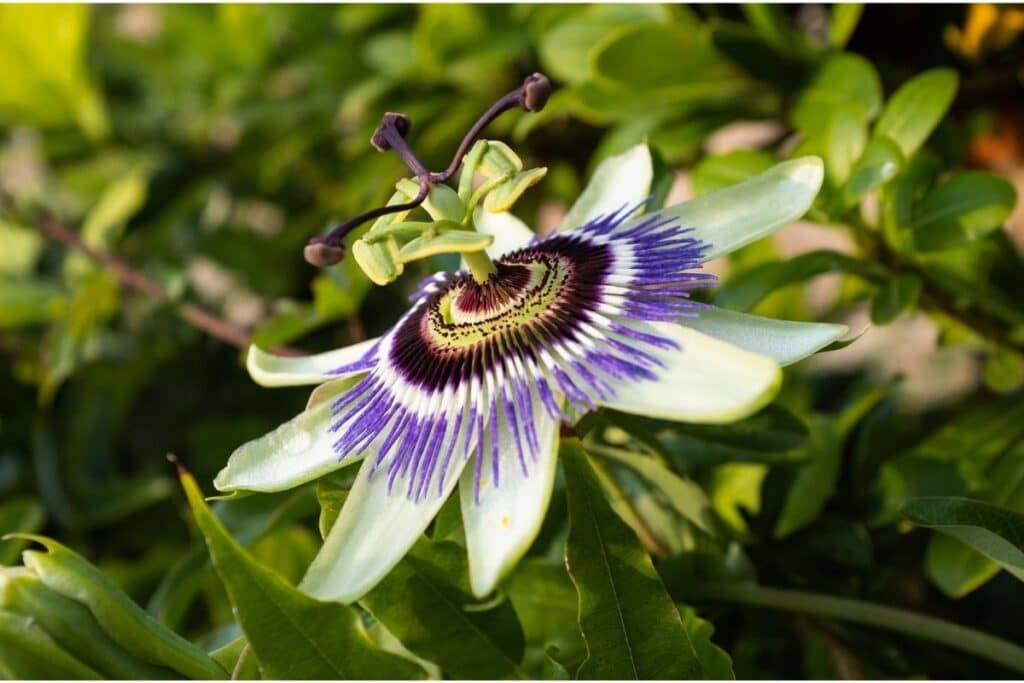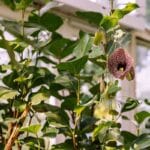Passion flower is definitely an exotic flower! This plant is an evergreen climber, which means you will need to choose its planting location carefully; otherwise, it will take over your garden.
Passion flowers will not only give you colorful flowers, but they will also provide you with some of the most delicious fruits ever!
Keep on reading and discover everything you need to know about passion flowers:
Passion Flower Facts
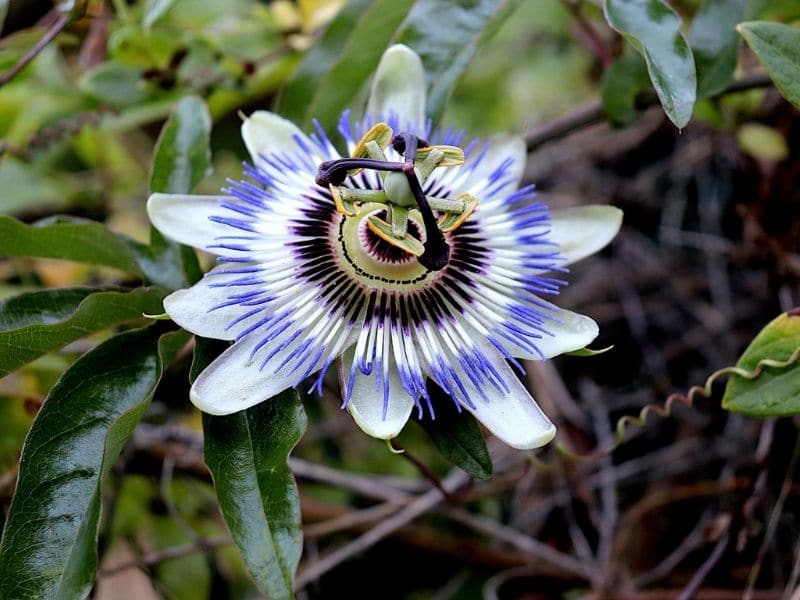
Passion flowers (also known as Passiflora or passion vines) are native to Central and South America because they prefer the tropical regions and weather of those specific locations.
In fact, the first written record that showed this flower was found in Colombia (1). The passion flower belongs to the family of plants Passifloraceae.
It has beautiful blooms and is a host plant for a few of butterfly species.
The unusual-looking flowers bloom from June to early fall but barely survive a day. Passionflowers will die back in the winter in colder locations, while certain varieties will remain evergreen in warm climes.
However, this is not to say you cannot grow passion flowers. If you live in a relatively warm area, then you can easily plant them!
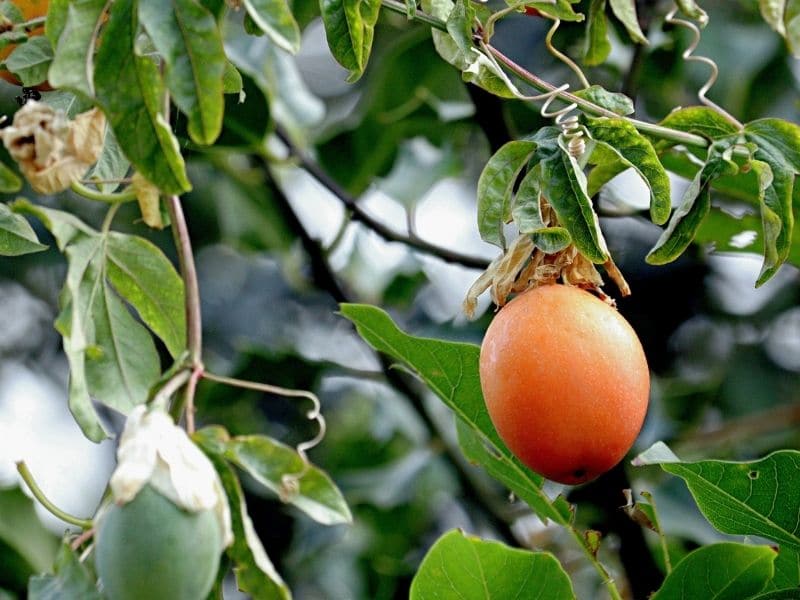
Follow these tips, and you’ll be growing your own passion flowers in no time:
How to Grow and Care for Passion Vines
I have tried to grow passion flowers from seeds, and I have failed every time. I later found out that growing it this way is challenging indeed, not to say almost impossible! I then decided to grow from a cutting, and it was a game-changer.
I would recommend you do this too, especially if you already have another passion flower plant. Bear in mind that they will take over the available space, so keep an eye on it; otherwise you will end up having a very long passion flower vine circulating all over your house.
Cut the already established passion flower at the beginning of spring; this way, you will have plenty of time to help your new plant thrive.
Growing from seeds
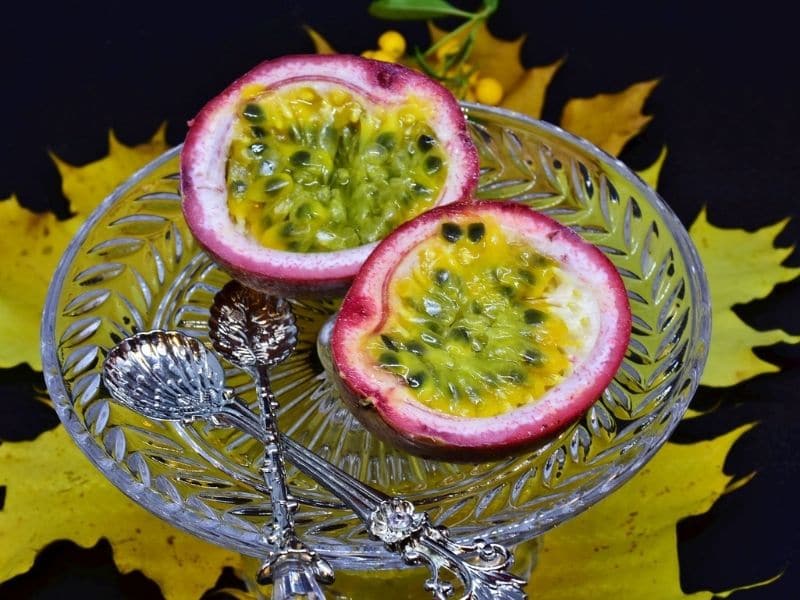
There are two methods for you to choose from:
Method one
You can try growing passion flowers from seeds: you will need to make sure the fruits are completely ripe before removing them. They are likely to take a long time to germinate, but you could quickly start this process by soaking the seeds in warm water; the floating seeds should be discarded.
Place the seeds that have sunk on a clean surface. Add some potting mix if you have any, but do not cover the whole seed as they still need some light in order to germinate fully. Place all of it in a plastic bag and close it tightly.
You will also need to be very patient as it could take months before seeing the seeds sprouting. It is advisable to maintain a moisture level within the bag until you see the seeds growing.
If this works, then you can take all of the germinated seeds out and transplant them as soon as possible.
Method two
Some cultivars will also leave the ripen fruits on a tray for at least two weeks. This will be plenty of time for the fruits (and the seeds) to start a fermentation process that will ultimately kill off some spores that could potentially harm the seeds.
After this process, they separate the seeds from the rest of the fruit and wash them thoroughly. Once they are completely dried, you will need to pour hot (not boiling) water so the seeds can get soft.
Once this is done, you will need to plant the seeds almost immediately. It takes longer than the previous method, but it is an excellent alternative to grow passion flowers.
Soil requirements
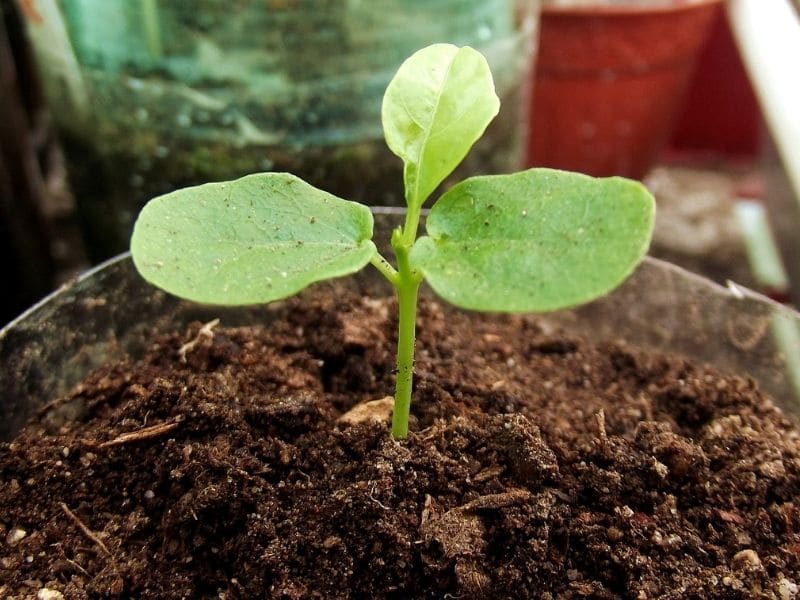
Similar to many types of vines, passion vines need well-drained soil as they cannot be thoroughly soaked. If you have heavy and compacted soil, try to improve its drainage before planting. You could do this by digging the area and mixing all of the soil until it is loosened.
You can also add compost before planting; this way, your soil will be moist.
Sunlight requirements
Sunlight is crucial for your passion for flowers to grow healthily. You will need to find a place where the plants are sheltered from cold winds and receive full sun.
If you live in an area where cold winters are the norm, make sure you create a hot and humid environment inside your greenhouse or any other closed areas; this will help your passion flowers develop fully as they would do in the tropics.
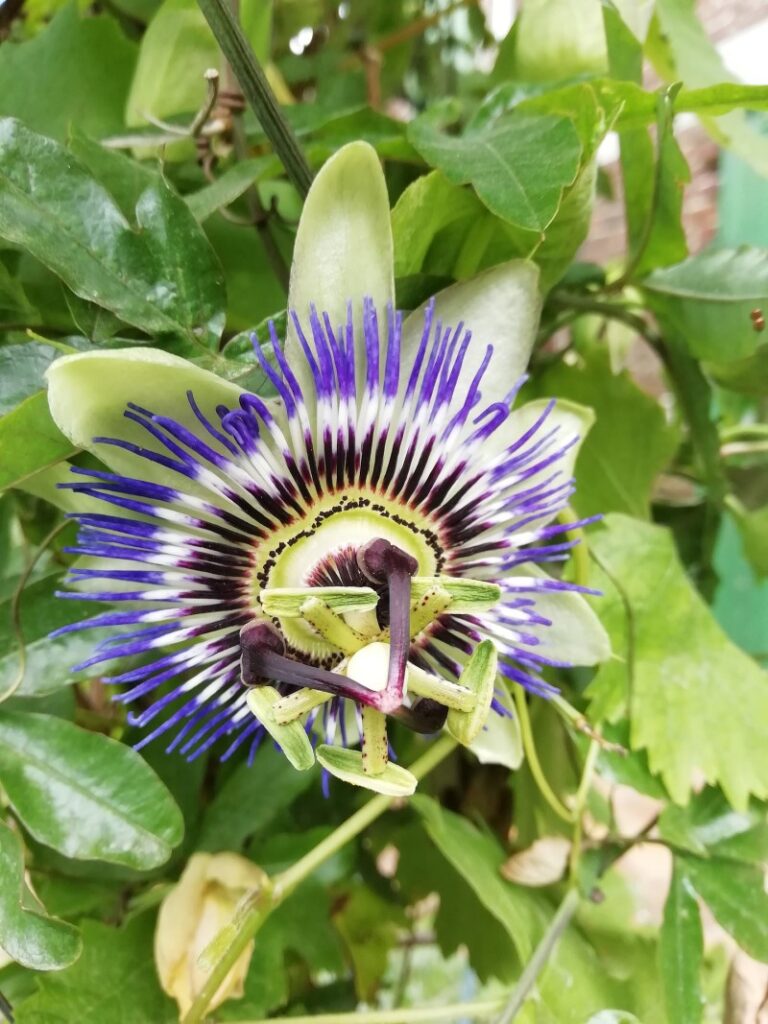
Water requirements
Passion flowers love water! You need to make sure they are thoroughly watered; otherwise, they won’t thrive. If your plants are growing, they will consume water abundantly, so you will need to provide this for them, especially if there is no rain.
You can put your fingers inside the soil to feel it; if it’s still moist, you can leave it as it is. If it’s completely dried, then you will need to water it more frequently.
Only water the roots and the soil, as these flowers hate having their leaves soaked. If it rains, then they will get wet and are not affected by this; however, if you continuously water the leaves, they can develop diseases.
Trellis requirements
You will need to either make or purchase a pergola, a trellis, or even an obelisk so your passion flowers can self-cling to them. If you grow these flowers in containers, you will still need to have some sort of support to rely on it.
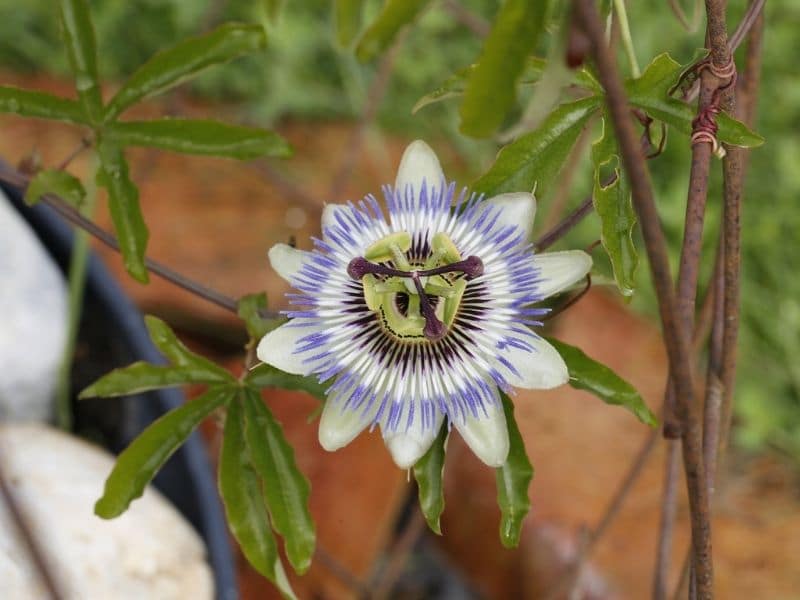
Pruning and training requirements
You can help your passion flower go wherever you want it to go! This way, you will also help her to produce better flowers.
As soon as you see your plant growing, you can cut some tips; this way, all the old branches will have more strength.
Always remember to prune during spring; otherwise, your plant could get damaged. On the other hand, you can train it as it grows; this way, you will choose where it will continue its path.
Pests and diseases
Unfortunately, these passiflora species could suffer from several types of diseases if they are not taken care of correctly. These vines can get viral infections, but you can easily remedy this by pruning all of the plant’s damaged parts.
However, it is essential to note that your gardening tools must be clean and disinfected at all times, especially if you are dealing with vine diseases. If not, these diseases can infect your tools as well, and you will be spreading around the problem throughout your garden and house!
Common Types of Passion Flowers
Most species of passionflower are low maintenance, these are the most common varieties of passion flowers:
Passiflora caerulea blue
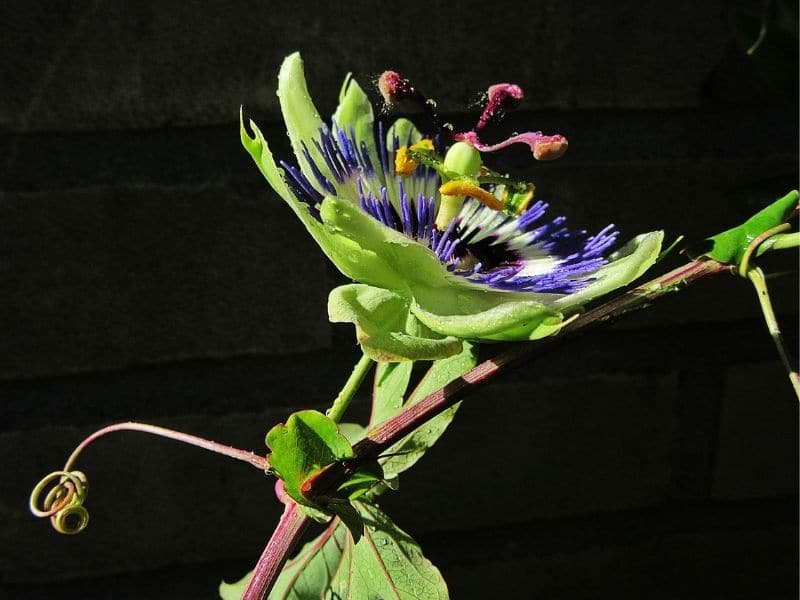
This type of flower has blue, green, and white petals. I can assure you it is so unique you will be blown away every time you see it! This passion flower will produce some fruits that resemble oranges.
Passiflora caerulea ‘’Constance Elliot’’
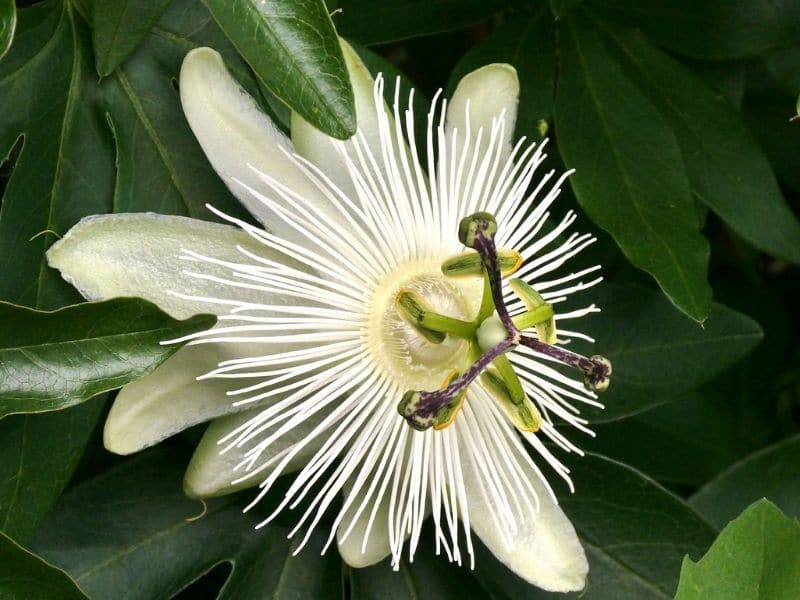
Even though the name is the same as the previous passion flower, this is a different variety. This passion flower only has white petals, and it is easily recognized thanks to its strong scent.
Passiflora edulis
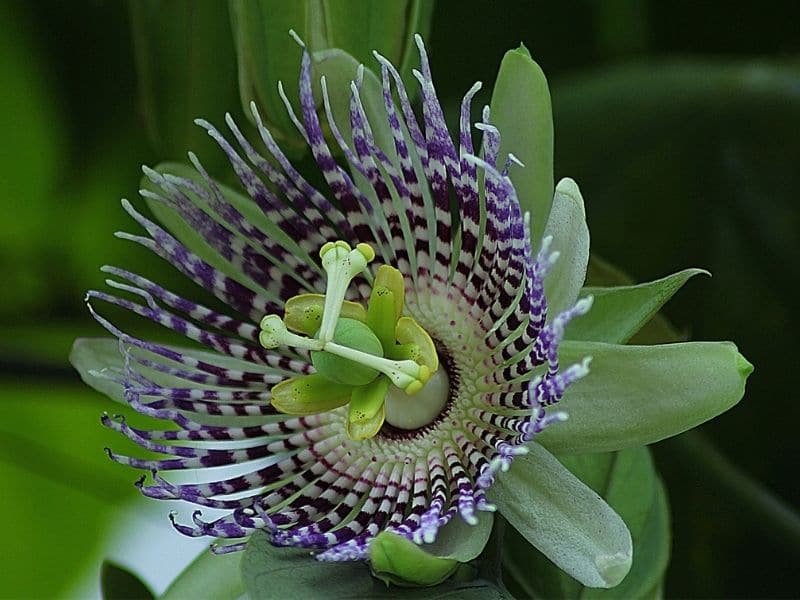
This passion flower has white and blue small petals. What’s interesting about this plant is that it produces black fruits (which are completely edible!) and are very nutritious (2).
Passiflora antioquiensis
This passion flower has small red and violet flowers. They do not tolerate hard climate conditions. From late summer to fall, the plant produces egg-shaped green fruits that, when mature, turn yellow to a deep orange color.
Passiflora mollissima
These flowers are so unique; you will not think they belong to the same variety of plants! This plant has tubular petals, and they tend to be pale-pink or white. They do not tolerate challenging climate conditions.
Passiflora incarnata
Undoubtedly one of the easiest passion flowers to recognize, you will not believe how pretty they are! This Passiflora incarnata flower has purple and white petals, and all of them have a thin-tubular shape; they also have great medicinal value (3).
Passiflora caerulea ‘’Grandiflora’’
As its name suggests, this passion flower is big! In fact, it is one of the biggest in its family as it can grow 6 inches across! They have white and violet petals.
Passiflora caerulea ‘’Amethyst’’
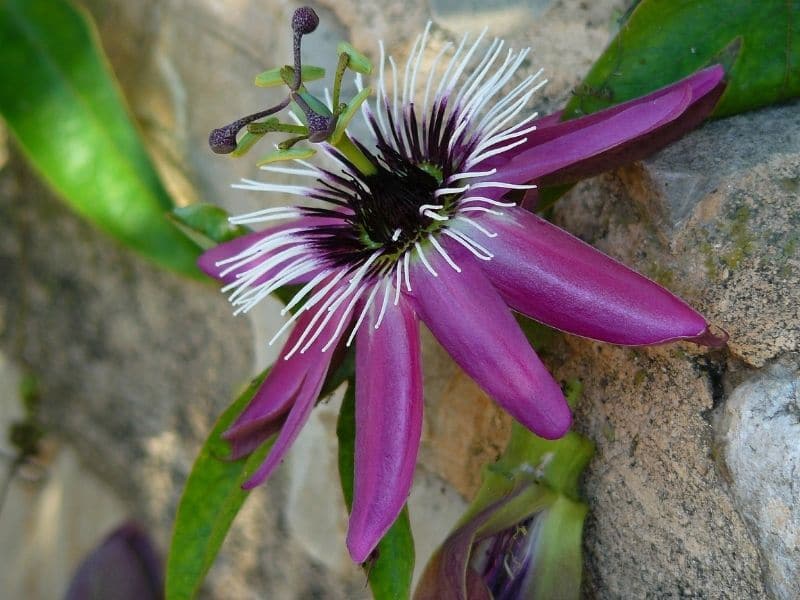
This passion flower is a purple flower vine that has purple petals. They will become darker as soon as they mature.
FAQs
Here are some important answers for your questions:
Are Passion Flowers indoor or outdoor plants?
Passion Flowers can be grown both indoors and outdoors. However, they generally thrive better outdoors where they can receive full sunlight and have room to climb and spread.
Can passion flower grow in pots?
Yes, Passion Flowers can grow in pots. Ensure the pot has good drainage, use a well-balanced potting mix, and provide proper support for the vines.
Why does my passion flower keep dying?
Several factors could contribute to a passion flower dying, including overwatering, underwatering, inadequate sunlight, or pest infestations. Assess the plant’s growing conditions and address any issues accordingly.
How long do passion flowers last?
The lifespan of individual passion flowers is relatively short, usually lasting around one day. However, the plant can produce new flowers continuously throughout the growing season, ensuring a more extended period of flowering overall.
Conclusion
If you ever thought about having your own passion flowers, then now it is your time to plant them! Passion flower is a fantastic alternative for butterfly gardening on shaded properties if you don’t mind vines climbing your trees.
In addition, these flowers have some unique and gorgeous blooms; I can assure you that if you grow passion flowers, then you will keep on saying ‘’wow’’ every time you look at them!
Up Next: Passion Flowers Meaning and Symbolism
References
Reference List
- Cerqueira-Silva, C. B., Jesus, O. N., Santos, E. S., Corrêa, R. X., & Souza, A. P. (2014). Genetic breeding and diversity of the genus Passiflora: progress and perspectives in molecular and genetic studies. International journal of molecular sciences, 15(8), 14122–14152. https://doi.org/10.3390/ijms150814122
- He, X., Luan, F., Yang, Y., Wang, Z., Zhao, Z., Fang, J., Wang, M., Zuo, M., & Li, Y. (2020). Passiflora edulis: An Insight Into Current Researches on Phytochemistry and Pharmacology. Frontiers in pharmacology, 11, 617. https://www.ncbi.nlm.nih.gov/pmc/articles/PMC7251050/
- Aman, U., Subhan, F., Shahid, M., Akbar, S., Ahmad, N., Ali, G., Fawad, K., & Sewell, R. D. (2016). Passiflora incarnata attenuation of neuropathic allodynia and vulvodynia apropos GABA-ergic and opioidergic antinociceptive and behavioural mechanisms. BMC complementary and alternative medicine, 16, 77. https://doi.org/10.1186/s12906-016-1048-6
- Da Fonseca, L. R., Rodrigues, R. A., Ramos, A. S., da Cruz, J. D., Ferreira, J., Silva, J., & Amaral, A. (2020). Herbal Medicinal Products from Passiflora for Anxiety: An Unexploited Potential. TheScientificWorldJournal, 2020, 6598434. https://doi.org/10.1155/2020/6598434
- Kaviani, N., Tavakoli, M., Tabanmehr, M., & Havaei, R. (2013). The efficacy of passiflora incarnata linnaeus in reducing dental anxiety in patients undergoing periodontal treatment. Journal of dentistry (Shiraz, Iran), 14(2), 68–72.
Close
*Image by depositphotos.com/2checkingout

